What to see
Slovenia is a small country rich in natural and cultural diversity. It stretches from the Pannonian basin to the Alps and the Sea, covered in forests, rivers and lakes above, as well as caves reaching deep below. Many of its natural treasures fall under protected areas and some of its autochthonous animal species are protected, too. Its urban centers often carry specific regional cultural features such as a wide variety of traditions and celebrations, as well as a specific culinary legacy. Below you can find a summary of what is worth seeing in some Slovenian regions.
This is where you live – the place where the sea and the sun reign supreme. The green valleys of Slovenian Istria offer a rich culinary tradition with local specialties such as truffles, olive oil, wine and sea salt. Here you can also find several towns with historical heritage reaching back to Venetian times such as Koper, Izola and Piran, as well as many small villages and corners waiting to be explored.
Close to the Croatian border lies the largest preserved natural park with salt pans on the Slovenian Mediterranean, the Sečovlje Salt Pans. Here, sea salt is still obtained manually by extraction from the few remaining fields. In addition, you can find a salt-themed wellness center in the middle of the park. Along the coastline you will find Portorož, a modern tourism-oriented town with a long promenade, a city beach and many hotels. The next town is the medieval port city with small windy roads and a rich cultural and historical background, Piran. In summer, Piran is filled with music and other cultural events. Strunjan, the neighboring town, features a flourishing nature park rich in local fauna and flora, and a bay with beautiful beaches, cliffs and salt pans. In Izola, you will find the popular beaches of San Simon and the Lighthouse beach, as well as an old town center and the regional hospital on top of the hill. From here, you can walk or cycle next to the sea towards Koper, the regional capital. If you enjoy a small hike, walk up the hill Socerb to enjoy a view on the coast and visit the local castle. Behind Koper, you will find the natural park Škocjanski zatok, boasting a large diversity of birds and wildlife.
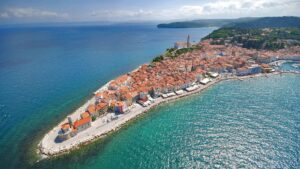
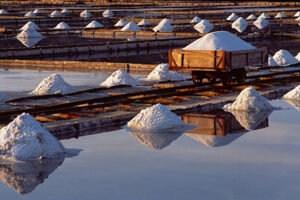
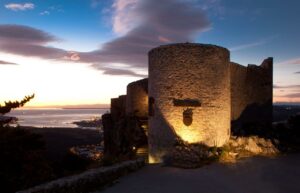
If you are a sports person, the coastal region offers numerous possibilities to enjoy some active free time. Cyclists can embark on a trip along the whole coastline on a well paved cycling lane nicknamed the Route of Health and Friendship. Formally named the D-8 cyclist lane, also named Parenzana after the train that used to ride here in the beginning of the 20th century, the track features two tunnels and fantastic views on green valleys, as well as the sea from above as well as beaches below, where you can swim. When the sea is calm, you can try paddling on a sup or a kayak, or alternatively taking off to the sky to try some sky-diving. For a light hiking trip, visit the hill Slavnik.
North of the Coastal region, bordering Italy, lies the Karst region. With its unique geological features, the Karst offers a rich natural landscape above as well as below the ground in one of its many cave systems open to visitors. Some of the most famous ones are the Postojna cave that features a passenger train to transport visitors to its depths, or the esthetically impressive Škocjan caves, a UNESCO world heritage site. Nearby the former cave you can find the Predjama castle, the worlds largest castle built in a cave. Some other caves in the region are the Divača cave, the Križna cave visited by boat or the oldest tourist cave, Vilenica cave. If you want to see the Cerknica lake, you have to come in the rain season as this intermittent lake dries out completely during dry season. Nearby, you can enjoy beautiful hikes in the green Rakov Škocjan valley or hike up the Nanos hill, offering fantastic views on the whole region. The Karst is also home to the autochthonous Lipizzan horse, bread on one of the oldest European horse farms in Lipica.
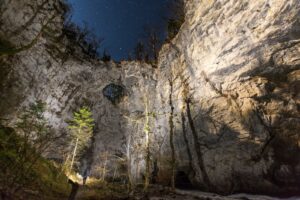
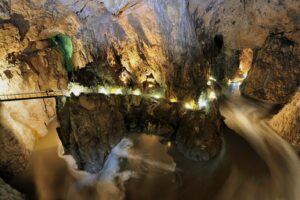
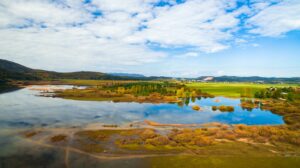
Slovenia features two Alpine ranges: to the west is the highest mountain range, the Julian Alps. This region features some of Slovenia’s most significant landmarks, such as the highest peak Triglav, with many hiking routes and numerous peaks in the vicinity worth visiting during the summer hiking season, when the mountain huts open. Following the streams of Alpine rivers, two major lakes take shape in the base of the mountains: The lake Bohinj with its crystal clear water and staggering panorama and the lake Bled, known for its beautiful central island with a church and a castle on a rock that overlooks the lake. A famous ski site extends to the north, attracting international tourists as well as world cup organizers in many alpine disciplines from skiing to ski jumping and ski running: Kranjska gora. The western part of the Julian Alps is significant for the Soča valley, which carries the pristine turquoise Soča river – a dream for all lovers of wild watersports.
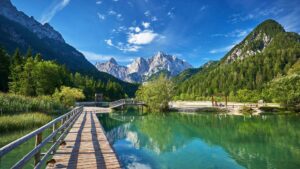
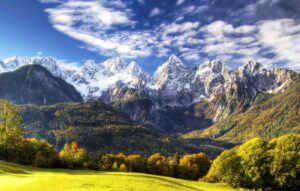
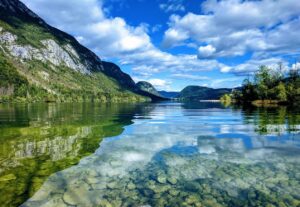
To the east of the Julian Alps, occupying the central northern area of Slovenia are the Kamnik-Savinja Alps. This lower Alpine region offers significant natural landmarks, such as the glacial Logar Valley with beautiful waterfalls, or the plateau Velika Planina, with its significant ethnological settlement and a cable car. At the east end of the Kamnik-Savinja Alps, south of the Drava river you find the mountain range Pohorje known for its skiing center as well as Slovenia’s second biggest town, Maribor.
The most intuitive place to visit in Central Slovenia is the country’s capital, Ljubljana. This green city offers plenty of tourist attractions, a pleasant and unique architecture and vibe, as well as a rich offer of social and cultural happening. In the immediate northern vicinity of the capital are the historical towns of Škofja Loka and Kranj, bordering on the Alpine region. Here you can also find the UNESCO Heritage Site town of Idrija. South of Ljubljana, you find the municipality of Kočevje with its primeval forest, also a UNESCO site. The Kolpa river offers great opportunities for rafting and kayaking, as well as exploring the nearby Bela Krajina region.
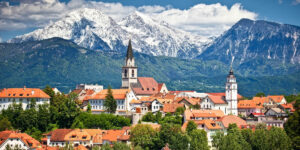
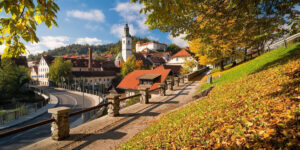
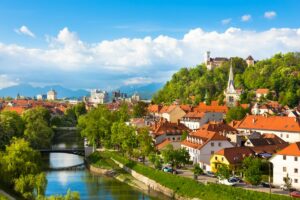
This region is significant for its thermal baths as well as good wine and many castles. To the south is the Dolenjska region, with is capital Novo Mesto on the river banks of the Krka river. A castle worth visiting in this region is Otočec, stunning with its romantic entourage. Northern of here, along the river Sava is the region Posavje. Here, you can walk in the UNESCO natural park Kozjansko and visit the royal castle Podsreda. This region is rich in castles and monasteries as well as other historical landmarks. Further north is a region along the Savinja river, known for its hop and beer production, particularly in the city of Laško, as well as Žalec, which features a beer fountain. The city of Celje offers a nice castle on top of a hill, home to generations of noble families that resided here. In the most north-eastern tip of Slovenia, you will find a region called Prekmurje, the Pannonian area influenced strongly by Hungarian culture. In the city of Lendava, you can visit the famous Vinarium lookout tower and stay over in a traditional pannonian house.
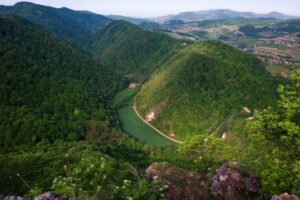
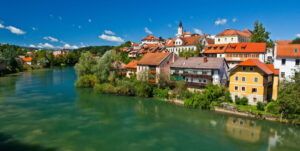
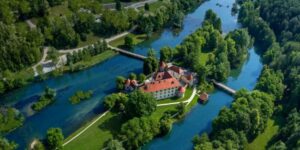
Visit I FEEL SLOVENIA for more information about tourism in Slovenia.
